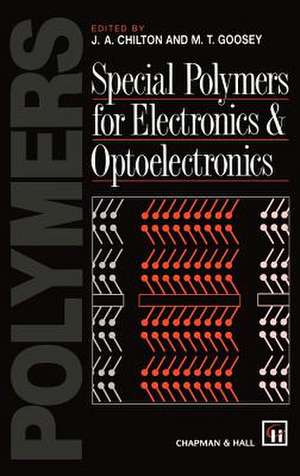Special Polymers for Electronics and Optoelectronics
Editat de J.A. Chilton, M. Gooseyen Limba Engleză Hardback – 28 feb 1995
| Toate formatele și edițiile | Preț | Express |
|---|---|---|
| Paperback (1) | 948.47 lei 6-8 săpt. | |
| SPRINGER NETHERLANDS – 3 oct 2012 | 948.47 lei 6-8 săpt. | |
| Hardback (1) | 954.62 lei 6-8 săpt. | |
| SPRINGER NETHERLANDS – 28 feb 1995 | 954.62 lei 6-8 săpt. |
Preț: 954.62 lei
Preț vechi: 1164.17 lei
-18% Nou
Puncte Express: 1432
Preț estimativ în valută:
182.67€ • 191.11$ • 151.74£
182.67€ • 191.11$ • 151.74£
Carte tipărită la comandă
Livrare economică 03-17 aprilie
Preluare comenzi: 021 569.72.76
Specificații
ISBN-13: 9780412584008
ISBN-10: 041258400X
Pagini: 351
Ilustrații: XXIV, 351 p.
Dimensiuni: 155 x 235 x 22 mm
Greutate: 0.71 kg
Ediția:1995
Editura: SPRINGER NETHERLANDS
Colecția Springer
Locul publicării:Dordrecht, Netherlands
ISBN-10: 041258400X
Pagini: 351
Ilustrații: XXIV, 351 p.
Dimensiuni: 155 x 235 x 22 mm
Greutate: 0.71 kg
Ediția:1995
Editura: SPRINGER NETHERLANDS
Colecția Springer
Locul publicării:Dordrecht, Netherlands
Public țintă
ResearchCuprins
1 Conductive polymers.- 1.1 Introduction.- 1.2 Traditional routes to conductive polymers.- 1.3 Conduction mechanisms.- 1.4 Conducting polymers.- 1.5 Applications.- 1.6 Conclusions and commercial prospects.- References.- 2 Electrodepositable resists.- 2.1 Introduction.- 2.2 Principles of electrodeposition.- 2.3 Polymers for electrodepositable resists.- 2.4 Electrodepositable resist formulation.- 2.5 Applications of electrodepositable resists.- 2.6 Summary and conclusions.- References.- 3 Polymeric Langmuir—Blodgett films.- 3.1 Introduction.- 3.2 Polymerization of Langmuir—Blodgett materials.- 3.3 Electrical properties.- 3.4 Optical properties.- 3.5 Concluding remarks.- References.- 4 Nonlinear materials.- 4.1 Introduction.- 4.2 Characterization.- 4.3 ?2 polymers.- 4.4 ?2 polymers.- 4.5 Polymeric devices.- References.- 5 Ferroelectric polymers.- 5.1 Introduction.- 5.2 Ferroelectric polymer materials.- 5.3 Properties of ferroelectric polymers.- 5.4 Applications of ferroelectric polymers.- 5.5 Conclusions.- References.- 6 Electroactive composites.- 6.1 Introduction.- 6.2 Composite designs.- 6.3 Diphasic models.- 6.4 Preparation and characterization.- 6.5 Composite poling.- 6.6 Applications.- References.- 7 Thermotropic liquid crystal polymers.- 7.1 Introduction.- 7.2 Liquid crystal polymer fundamentals.- 7.3 Processing.- 7.4 Property profiles.- 7.5 Applications.- 7.6 Outlook.- References.- 8 Photoconductive polymers.- 8.1 Introduction.- 8.2 General background.- 8.3 Materials.- 8.4 Experimental techniques.- 8.5 Applications.- References.- 9 Polymers for optical data storage.- 9.1 Introduction: the need for optical storage.- 9.2 The principles of optical storage.- 9.3 Polymers in the recording layer.- 9.4 Polymers in the manufacture of optical media.- 9.5 Polymers foroptical heads.- 9.6 Polymers for cartridges.- 9.7 Other forms of optical storage.- 9.8 The future for polymers in optical data storage.- References.
Recenzii
...this book is an excellent introduction to the applications of polymer science in the opto-electronic industry...I recommend the book for entry-level researchers or specialists desiring expansion into a new field - Trends in Polymer Science; This book is very timely and brings together, concisely, an authoritative discussion of topics. - Polymer International; This is a fascinating book...each page contains a large amount of information which is presented in a very clear and logical way. This means that although the book is written by a number of different authors, that the book has a coherent style. The text is also well illustrated...this book will be of great interest to those working in the electronics industry and/or, those studying/researching electronics. - Engineering Plastics










